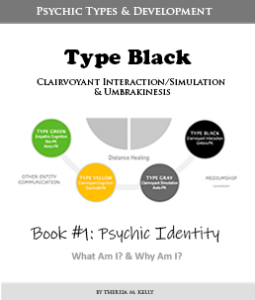- What Am I? (Type Black)
- Psychic Ability (Type Black)
- Dreams Impressions & Hallucinations (Type Black)
- Clairvoyant Interaction (Type Black)
- Trance Mediumship (Type Black)
- Channeling (Type Black)
- Physical Mediumship (Type Black)
- Clairvoyant Simulation (Type Black)
- Input CS (Type Black)
- Output – Probability Shifting (Type Black)
- Output- Historical Shifting (Type Black)
- Changing The Past (Type Black)
- Intention (Type Black)
- Intention #2 (Type Black)
- Adaptive or Directive? (Type Black)
- Adaptive or Decisive? (Type Black)
- Input or Output? (Type Black)
- Trance Mediumship or Channeling? (Type Black)
- Your Sources (Type Black)
- People, Places, Objects & Ideas (Type Black)
- People, Objects & Events (Type Black)
- Precognition & Probability Shifting (Type Black)
- Contemporaneous Input & Real-Time (Type Black)
- Postcognition & Historical Shifting (Type Black)
- Episodes (Type Black)
- Experience Modes (Type Black)
- Other Terms for CI and CS (Type Black)
- You Are Not Alone: CS & CI (Type Black)
- Magical Thinking & Psychic Confusion (Type Black)
- The Difference Between Types of ESP (Type Black)
- The Difference Between Types of ESP II (Type Black)
- Seriously? (Type Black)
- Having Doubts: CS & CI (Type Black)
- Psychokinesis (Type Black)
- Forms of Psychokinesis (Type Black)
- PK or CS Healer? (Type Black)
- Science Crash Course (Type Black)
- Umbrakinesis (Type Black)
- Umbra-PK Subtypes (Type Black)
- Umbrakinesis Part II (Type Black)
- Normal or Paranormal? (Type Black)
- Light or Thermal Healer? (Type Black)
- Umbra-PK & Physical Mediums (Type Black)
- Did You Know You Are Not Alone? (Type Black)
- Having Doubts? (Type Black)
- One Last Question (Type Black)
DREAMS, IMPRESSIONS, & HALLUCINATIONS
Generally speaking, every extrasensory experience can be separated and labeled as an intuitive impression, hallucination, or dream (realistic or unrealistic).
Realistic dreams are defined as dreams that are not necessarily completely literal when looking at the big picture, but the information does not include the quality of being described in a disguised form. Usually, realistic dream experiences are more detailed in content than that of intuitive or hallucinatory experiences.
Unrealistic dreams are similar to realistic dream experiences, but here the imagery, or mental images, are more dramatic and fantasy-like. Important features may appear realistic, but the scene or situations surrounding the features appear disguised like they are in a symbolic form.
Intuitive impressions cover any extrasensory experience that includes a general unreasoned impression or hunch. With intuitive experiences, there are no pictures, images, sounds, smells, and so forth, nor any clearly known thought process leading to the impression. The experiencer just suddenly “knows” something, usually describing an unclear impression, that when examined later on was found to be supported at least a little bit. Intuitive impressions where an experiencer “feels” the emotions of another person, is today commonly referred to as psychic Empathy.
Hallucinations in relation to extrasensory experiences refer to seeing something that others cannot see or that is not physically present. Suggesting that an extrasensory experience is a hallucination does not mean that what the person is seeing is not real, just that it’s not necessarily physically there.
Hallucination experiences can involve a flash of an image or person not physically there, usually seen in the mind rather than in one’s surroundings, or the sound of someone talking that is not there, and are perceived while conscious and awake. Hallucinations can happen in any sensory mode including visual (sight), auditory (hearing), olfaction (smell), gustatory (taste), tactile (pressure/touch), equilibrioception (balance), thermoception (temperature), chronoception (time), and so on. Hallucinations usually involve images drawn from or built from, internal representations of the world held in the long-term memory of the mind.
“This means if a person has a hallucination experience of let’s say a lotus flower, but has never seen a lotus flower before, then the experiencer will see an image of a similar flower they have already actually seen in the past, let’s say a water lily.”
Therefore, the more a person has experienced, such as seen and heard, the more a person will be likely to fully construct, and therefore understand, hallucination information.








